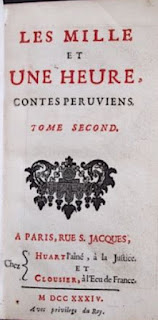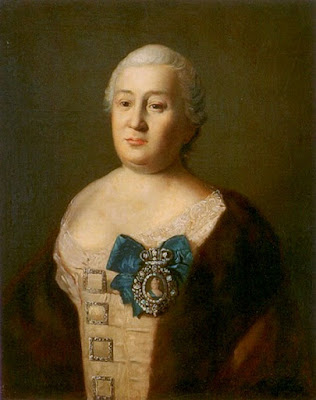007.3. Empress Elizaveta Petrovna / Елизавета Петровна
 To finish up with the Empress Elizabeth, Golicyn (110) credits her with two other literary works: an unfinished acrostic and a "pastoral song." Both are untranslated, to my knowledge, and thus represent (together with the other two poems attributed to Elizabeth and discussed in the last two posts) potential projects for students who would like to try a hand at translating.
To finish up with the Empress Elizabeth, Golicyn (110) credits her with two other literary works: an unfinished acrostic and a "pastoral song." Both are untranslated, to my knowledge, and thus represent (together with the other two poems attributed to Elizabeth and discussed in the last two posts) potential projects for students who would like to try a hand at translating.The acrostic was first published in the Vorontsov Archive among Elizabeth's letters to statesman Michail Illarionovič Vorontsov in 1870. Judging from the dated letters published on either side, it was penned between 1742 and 1745. According to the editors of that volume, the acrostic is written in Elizabeth's own hand – no guarantee, of course, that she herself actually wrote it instead of merely copying it from another source. The words in cursive in the right-hand margin, an editorial note suggests, are added corrections. Whether these are Elizabeth's own or those of a contemporary or later editor is not specified; it was not unusual for heads of state to submit their writings to secretarial staff or literarily inclined intimates for suggestions or revisions. At any rate, this acrostic seems the most likely of the four pieces credited by Golicyn to Elizabeth to have actually been hers since it illustrates what we might expect from someone with little or no interest in the literary craft: it is incomplete and opaque, referring to circumstances that are now obscure:
Сия удивлейна ныне учинилась,
А что любовь сама во глупость вселилась Тебе уязвила
Мыслила тую болей в ум свелити,
А ан! стала тая еще глупее быти.
Ревность пресильна в ней пребывает И себя мертвит.
И сама не знает, кто ее умерщвляет;
На то уповает, что сама не знает. В
безумстве бывает
Сом.
О.
Б.
Л.
Е.
An acrostic is a literary conceit designed so that the first letters of each line, read from top to bottom, spell out a word of some significance – generally
representing the "solution" to the clues elaborated in the
lines of verse. The general theme here is an event in which love,
misled and confused, has become "still stupider" ("stinging
you", suggests the marginal note), meanwhile jealousy is brought
into play, "paralyzing love", says the edit, and subjecting
it to both destruction and loss of hope. Who loves whom is not clear.
Nor is the sense of the lines' first letters ("Samarinsoble",
"Samarin.SOBLE" or "Samarin.Som.Oble"), although
it can be surmised that these lines refer to affairs of the heart
involving someone named "Samarin". This is not an unusual
surname and at least two Samarins, Nikolaj Michajlovič and his
brother Ivan Michajlovič, were visible figures in Elizabeth's era.
The fourth and last supposedly Elizabethan text is a song, written, according to Golicyn, before 1740 and published in various song collections from the late 1700s; he cites one from 1791. Where the attribution to Elizabeth originated is not clear, nor whether or not this song was recorded in any song collections prior to 1791. While Golicyn provides only two lines of the song, he points the way to the rest of the text, which can be found in an essay on lyric poetry by the well-known poet Gavriil Deržavin.[1] In this essay, dated 1811-1815, Derzhavin looks back to the era of his youth, asserting that "the age of Elizabeth was the age of songs" (607). After a discussion of the song's specific characteristics with respect to the more formal ode, he provides the lines of a "pastoral song" that "according to legend" represent Elizabeth's own contribution to the genre (609-10):
Чистый источникъ! всѣхъ цвѣтовъ красивѣй,
Всѣхъ пріятнѣй мнѣ луговъ
Ты и рощъ всѣхъ, ахъ! и меня счастливѣй,
Горъ, долинокъ и кустовъ;
Но не тѣмъ, что лишь струйки тихо льются
По сыпучему песку
И что птичекъ въ слухъ пѣсни раздаются
По зеленому лѣску.
Нѣтъ, не тѣмъ; но прекрасно умывала
Нимфа что лицо тобой,
Съ брегу бѣлыя ноги опускала
И токъ украшала твой.
Тутъ и алыя розы устыдились,
Зря ланиты и уста,
И лилеи къ ней на грудь преклонились,
Что бѣлѣй ихъ красота.
О, коль счастливы желтыя песчинки,
Тронуты ея стопой!
О, коль пріятны легкія травинки,
Смятыя ея красой!
Тише жъ нынѣ, тише протекайте,
Чисты струйки по песку
И слѣдовъ съ моихъ глазъ вы не смывайте, —
Смойте лишь мою тоску.
 This verse, born of an inspiration that is classical rather than
folkloric, differs sharply from "In the Village of Pokrovskoe"
in its style, tone, and subject matter. We are invited to contemplate
the interaction of different natural elements – a spring, flowers,
groves, and so on – with a lovely nymph
who bathes in the stream, inflaming the desires of the singer,
presumably male.
This verse, born of an inspiration that is classical rather than
folkloric, differs sharply from "In the Village of Pokrovskoe"
in its style, tone, and subject matter. We are invited to contemplate
the interaction of different natural elements – a spring, flowers,
groves, and so on – with a lovely nymph
who bathes in the stream, inflaming the desires of the singer,
presumably male.
Would such a composition have been within Elizabeth's capabilities or
stylistic range? Did other women poets write classically themed
pastoral verses from a male point of view? Golicyn's specification
that this verse was written "before 1740", i.e. before
Elizaveta Petrovna became Empress, suggests that we link it, too,
with blithe days at Pokrovskoe, filled, as tradition has it, with
riding, singing, and penning occasional verses – in strikingly different tones and genres. More biographical research is needed
here, but it seems doubtful that Elizabeth wrote the three poems that
Golicyn credits to her, each of them a complex and articulated
literary text in a distinct style. She is commonly associated with
opulence, fashion, and the
rise of the French language at
the Russian court,
but Elizabeth's reign
was also hospitable
to the arts: she enjoyed
theater, appreciated poetry (especially when she was its subject),
and supported literary
publishing, which noticeably picked up speed under
her rule (Marker
55). Literary journals began to appear and it was towards the end of
Elizabeth's reign that women's writing was published in Russia for
the first time.
Further
Reading:
Archiv Knjazja Voroncova. Knigapervaja. Bumagi grafa Michajla Larionovica Voroncova. M.: Tip. A. I.
Mamontova i Ko., 1870. Pp. 9-10 .
Deržavin,
Gavriil. "Rassuždenie o liričeskoj poesii". In Sočinenija
Deržavina
[v 9 tomach], ed. Ja. Grot. Vol. 7. SPb.: Izd. Imp. Akad. Nauk, 1872. Pp.
516-628.
Marker,
Gary. Publishing, Printing, and the Origins of Intellectual Life
in Russia. Princeton: Princeton Univ. Press, 1985.
Notes:
[1]
The
first two lines in Golicyn's version of
this song are
slightly
different: "Чистый
источник, ты цветов краснейший, /
И
мне приятнее всех роз."
Illustrations:
1.
Portrait of Elizaveta Petrovna by Ivan Argunov, circa 1750s-1760s (Courtesy of Wikimedia Commons).
2. Equestrian Portrait of Elizaveta Petrovna by Georg Caspar Prenner, 1741-1755 (Courtesy of Wikimedia Commons).
2. Equestrian Portrait of Elizaveta Petrovna by Georg Caspar Prenner, 1741-1755 (Courtesy of Wikimedia Commons).
3. Portrait of Elizaveta Petrovna in Man's Clothing by Louis Caravaque, 1745 (Courtesy of Gosudarstvennoe upravlenie v Rossii v portretach s IX po XXI vek).




Comments
Post a Comment